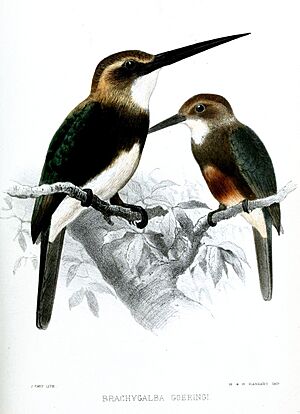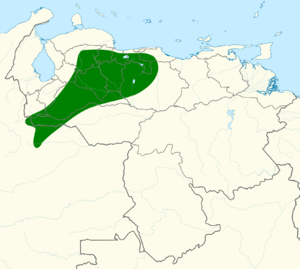Pale-headed jacamar facts for kids
Quick facts for kids Pale-headed jacamar |
|
|---|---|
 |
|
| Conservation status | |
| Scientific classification | |
| Genus: |
Brachygalba
|
| Species: |
goeringi
|
 |
|
The pale-headed jacamar (Brachygalba goeringi) is a cool bird that lives in the forests of Colombia and Venezuela. It's part of the Galbulidae family, which are known for their bright colors and long, pointed beaks. These birds are often seen catching insects in the air, almost like a feathered dart!
Contents
About the Pale-headed Jacamar
What's in a Name?
The pale-headed jacamar is a unique bird. It's the only species in its group that doesn't have other subspecies. Think of it like a one-of-a-kind model!
It's also part of a "superspecies" with a few other jacamars. This means they are very closely related. These relatives include the dusky-backed jacamar, the brown jacamar, and the white-throated jacamar.
How to Spot One
The pale-headed jacamar is about 16.5 to 18 centimeters (6.5 to 7 inches) long. It weighs around 16 to 18 grams (0.56 to 0.63 ounces). That's about as much as a few pieces of candy!
Male jacamars have an ashy brown color on their head, neck, and shoulders. The rest of their upper body is dark brown with a greenish shine. When their feathers get older, they can look blue-black. They have a light stripe above their eye and a buffy-white throat. Their upper belly has a chestnut band, and the sides of their body are dark brown. The rest of their underside is white.
Female jacamars look almost exactly like the males. Young jacamars have a gray head and neck. Their upper parts are brighter, and their green shine is even stronger.
Where They Live
You can find the pale-headed jacamar in parts of Colombia, like the Arauca and Casanare areas. From there, they spread north into northwestern Venezuela, reaching at least the Lara state.
These birds love to live on the edges of forests, especially "gallery forests." These are forests that grow along rivers in open grasslands called llanos. They also like younger, growing forests. While they can live as high as 1,100 meters (3,600 feet) above sea level, they usually prefer much lower areas.
Life and Habits
What They Eat
The pale-headed jacamar's favorite food is insects! They especially enjoy eating butterflies and dragonflies.
These birds often sit on branches that stick out from trees. They usually hunt in pairs or small family groups. When they see a flying insect, they quickly fly out to catch it in mid-air. It's like they're playing a game of catch!
Reproduction and Nests
Pale-headed jacamars build their nests in burrows. These burrows are dug into earth banks, like the side of a river or a hill.
In Venezuela, people have seen them nesting during the months of April and May.
Their Song
The pale-headed jacamar has a special song. It starts with a series of high "weet" notes. These notes get faster and higher in pitch as the song goes on. It then finishes with a fast, trembling sound called a trill. You can listen to their song online if you want to hear it!
Conservation Status
The IUCN (International Union for Conservation of Nature) has looked at the pale-headed jacamar. They have decided that this bird is of "Least Concern." This means that it's not currently in danger of disappearing.
The bird is "common throughout its range," which is good news! Even though some forests are being cut down, there aren't any specific threats that worry scientists right now.


